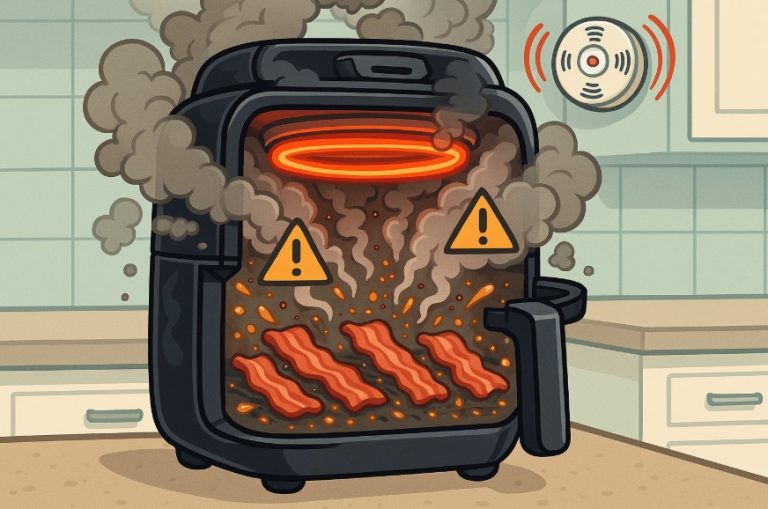Why Are Slugs Coming in My House at Night? Causes & Prevention Tips
Waking up to a trail of silvery slime across your floor or finding a slug quietly lurking in your kitchen isn’t anyone’s idea of a pleasant morning. Slugs invading homes at night is a surprisingly common issue, particularly in the UK where the damp climate offers them the ideal outdoor and indoor conditions.
These creatures are not only unsightly but also bring with them questions about cleanliness, property maintenance, and even health concerns.
If you’ve been wondering why are slugs coming in my house at night, the answer lies in a combination of their natural behaviour, environmental factors, and vulnerabilities in your home. This in-depth guide explores why slugs venture inside, how they manage it, and most importantly what you can do to stop them for good.
Why Are Slugs Coming in My House at Night?
Slugs are nocturnal animals that thrive in dark, cool, and moist environments. During the day, they hide away to conserve moisture and avoid predators. At night, however, they emerge to feed, explore, and seek shelter. Unfortunately, homes particularly those with certain vulnerabilities can become inviting spaces for them.
A Search for Shelter and Survival
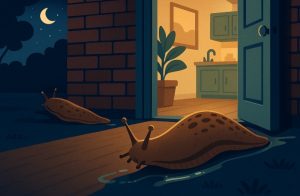
Slugs do not enter homes for social reasons; they’re in survival mode. As outdoor conditions become hostile especially during heavy rainfall, dry spells, or cold snaps your home presents a stable, damp, and relatively predator-free environment.
Central heating, indoor plumbing, and accessible hiding spots all contribute to making the indoors attractive.
How Seasonal Changes Influence Slug Activity?

Slug invasions tend to peak during spring and autumn. These seasons offer the kind of weather slugs love: mild temperatures combined with frequent rainfall. It’s also during these periods that slugs breed and are more actively searching for food.
When paired with the UK’s damp climate, it’s no surprise that homeowners often report more slug sightings around this time.
What Attracts Slugs Indoors After Dark?
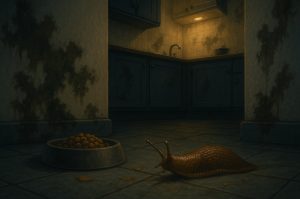
Slugs follow very basic instincts, and the environment inside a house can unknowingly trigger them. Moisture, warmth, and food play a huge role in drawing these creatures across your threshold.
Moisture: The Primary Attraction
Moisture is not just appealing to slugs, it’s essential. Their bodies are composed mostly of water and they breathe through their skin, which must remain moist to function properly. High humidity, condensation, and damp patches provide the hydration they need to survive. Bathrooms, utility rooms, and kitchens especially in older properties or poorly ventilated spaces are prime hotspots.
Food Sources Inside the Home
Slugs feed on a wide range of organic matter. In a domestic setting, this could include:
- Decaying houseplant leaves or soil
- Pet food left out overnight
- Spilled food crumbs on floors or counters
- Mould or fungi in damp corners or behind walls
They’re not looking to raid your fridge, but accessible food—even microscopic matter—can sustain them and keep them coming back.
A Safe Haven from Predators and Weather
Indoors, slugs are safe from birds, frogs, and hedgehogs. If the outdoor environment becomes too hot, cold, or dry, your home offers consistency and comfort. They can move in quietly and, once inside, may set up a semi-permanent base unless actively removed.
How Do Slugs Get Into Homes at Night?
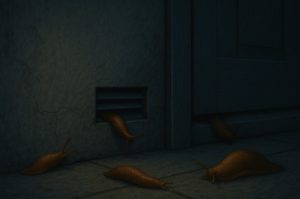
Despite their size and slow speed, slugs are remarkably capable of infiltrating homes. Their soft bodies can squeeze through spaces that would surprise most homeowners.
Common Structural Entry Points
- Gaps beneath external doors: Often the number one culprit.
- Unsealed wall cracks: Slugs can crawl through even hairline cracks.
- Open or uncovered vents: Essential for airflow, but an open door for pests.
- Around plumbing and cables: Utility entry points often have small openings not properly sealed.
Slugs typically enter at ground level, but their ability to climb walls and other vertical surfaces means even mid-height entry points shouldn’t be dismissed.
Slugs leave behind a trail of mucus that helps them navigate. These trails act as a form of memory, allowing them to return to your home night after night once a route has been discovered. This behaviour explains why you might see slugs repeatedly entering from the same point or appearing in the same rooms.
How Can You Tell If There’s a Slug Infestation in the House?
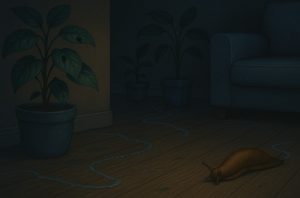
A one-off slug might seem innocent, but repeated sightings should raise a red flag. Knowing what to look for will help determine if you’re facing an infestation.
Identifying Slug Trails and Residue
One of the most visible signs of slug activity is their trail—thin, shiny mucus streaks that reflect light. These trails are usually found across hard flooring but can also appear on carpets, tiles, and walls.
Damage to Indoor Plants and Surfaces
Slugs nibble on foliage and will happily munch on potted plants inside your home. Leaves may appear ragged, chewed, or torn. Slugs may also damage wallpaper or floor underlay if left unchecked.
Foul Smells or Signs of Decay
Areas where slugs gather—particularly if there are multiple—can develop a damp, musty smell due to decaying matter and waste. If this smell is present and unexplained, slugs could be hiding nearby.
Where Do Slugs Hide Inside the House During the Day?
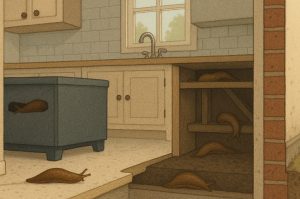
Slugs avoid light and dryness, so during the day they find secluded, moist spaces to hide.
Common Daytime Hiding Spots
- Behind kitchen or bathroom cabinets
- Beneath washing machines and dishwashers
- Under floor mats and carpets
- In wall cavities or under floorboards
- Inside damp cupboards or under sinks
They are mostly inactive during the day and emerge once darkness returns.
How to Prevent Slugs from Entering Your Home?
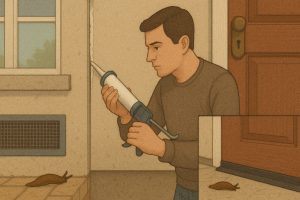
Prevention is more effective than repeated removal. Once you understand where and why slugs are entering, you can take targeted action to stop them.
Seal Off Entry Points
Examine your home carefully, especially at ground level. Use weather stripping, silicone sealant, or expanding foam to block any potential entryways. Door sweeps are essential if your doors do not fit snugly to the ground.
Cover Vents and Air Bricks
Fit fine mesh over ventilation openings. This allows air to flow but blocks pests. Ensure any mesh used is rust-resistant and securely fastened.
Reduce Dampness Indoors
- Use dehumidifiers in rooms with high humidity
- Fix any leaks under sinks or around pipes
- Improve ventilation in kitchens and bathrooms
- Avoid overwatering houseplants
A dry environment is less attractive to slugs and will discourage them from entering or settling inside.
Maintain Cleanliness and Hygiene
Make sure food is stored properly and any crumbs or spills are cleaned promptly. Avoid leaving pet food out overnight and regularly check under appliances for food build-up.
What Natural Slug Deterrents Can You Use Indoors?
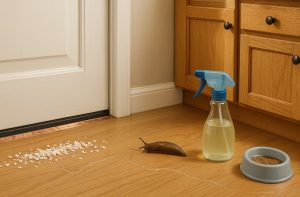
Chemical solutions are effective but may not be safe for indoor use, especially in homes with pets or children. Thankfully, several natural remedies are known to deter slugs without posing a risk to your household.
Copper Tape
This is one of the most popular and effective natural barriers. When slugs attempt to cross copper, they receive a mild electric-like shock, which repels them without killing.
Essential Oils
Scents such as peppermint, eucalyptus, garlic, or citrus are disliked by slugs. You can dilute essential oils with water and spray them around suspected entry points or hiding spots.
Barriers Using Texture
Materials like crushed eggshells, coarse sand, or grit can be placed near entryways. Slugs dislike crawling over rough textures and will avoid these areas.
What Long-Term Strategies Help Control Slugs Indoors?
While immediate solutions can eliminate current invaders, long-term strategies are needed to keep them from returning.
Regular Home Maintenance
Check your home’s exterior annually for cracks, broken vents, or worn-out seals. Make a habit of inspecting behind appliances and under sinks for dampness and signs of pests.
Keep the Perimeter of Your Home Clean
Slugs often come from gardens or underbrush near your property. Trim back vegetation, clear out compost or leaves near the foundation, and don’t leave pots or objects leaning against the walls of your home.
Consider Slug Traps
Beer traps and citrus peels placed near suspected entry points can lure slugs away from more sensitive areas. These can be used for monitoring and control, although they may not completely eliminate the problem on their own.
Seek Professional Help for Severe Infestations
If slugs continue appearing despite your best efforts, consider contacting a pest control expert. They can perform a full inspection and offer treatments or advice tailored to your property.
Which Slug Prevention Methods Are Most Effective?
| Method | Use Case | Effectiveness | Indoor Safe? | Long-Term? |
| Door and Gap Sealing | Preventing access | Very High | Yes | Yes |
| Copper Tape | Around entry points | High | Yes | Yes |
| Salt Barriers | Spot deterrent | Moderate | No (messy) | No |
| Dehumidifier | Moisture control | High | Yes | Yes |
| Essential Oil Spray | Natural repellent | Moderate | Yes | No |
| Professional Pest Control | Severe infestations | Very High | Yes | Yes |
How Can You Stop Slugs from Visiting Your Home at Night?
The key to stopping slugs is to think like one: What would they need? What do they avoid? Once you start viewing your home from a slug’s perspective, you can begin to eliminate the conditions that attract them.
By reducing dampness, sealing access points, removing food sources, and using natural deterrents, you disrupt the comfort and accessibility slugs seek. Consistency is vital. A one-off fix won’t be enough; regular checks and maintenance will help ensure they don’t return.
FAQs About Slugs Entering Homes
Can slugs damage my home?
While they don’t chew through structures, slugs can damage wallpaper, carpets, and plants. Their slime can also stain surfaces and pose hygiene concerns.
Are slugs dangerous to pets?
Some slugs may carry parasites harmful to dogs and cats if ingested. It’s best to remove slugs promptly and clean any area they’ve contacted.
Why are slugs only coming into one room?
Certain rooms may have more moisture, plant material, or easier access points. Slugs typically gravitate to the most suitable environment.
Do slugs come up through drains?
Rarely. However, damaged or open pipework might allow them access, particularly from underneath older homes.
Are certain home materials more attractive to slugs?
Homes with wooden floorboards, old stone walls, or minimal insulation are more prone to harbouring damp, making them more attractive to slugs.
Can slugs climb furniture?
Yes, slugs can climb vertical surfaces and may reach furniture, walls, or shelving if the conditions allow.
Should I kill slugs I find indoors?
That’s a personal choice. Many prefer humane removal by relocating them outdoors. However, if they’re repeatedly entering, a more systemic approach is required.





